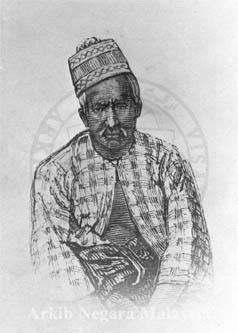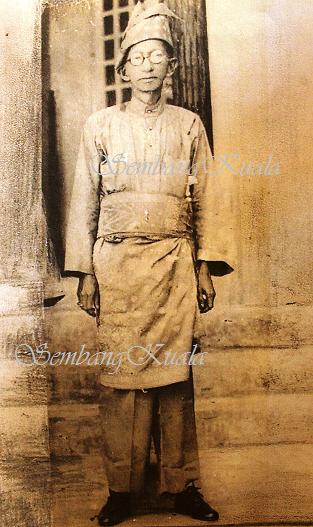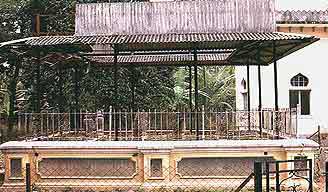
Sultan Yusuf Sharifuddin Muzaffar Shah Ibni Almarhum Sultan Abdullah Muhammad Shah I (1886 - 1887). Source: Arkib Negara Malaysia
According to Frank Swettenham, Sultan Yusuf was not the kind of man who makes friends and influences people but he had great gifts – intelligence, ability and he was a strong man with a will. He also added that Sultan Yusuf was a ruler who intended to rule. That was why it took him a while to reach the throne. Sultan Yusuf had been born to high office, being the eldest son of Sultan Abdullah Muhammad 1 (1851-1857).
In those days at the beginning of the nineteenth century, Perak was beginning to break up. During that time, it was no longer possible to keep the State really united under the control of a single authority. It became necessary to share the office of Sultan between the branches of the royal house. At any time, the Sultan was drawn from one branch of the dynasty, the Raja Muda from another and the Raja Bendahara from the third.
Thus, when a Sultan mangkat, the Raja Muda would become the next Sultan, the Raja Bendahara would be promoted to Raja Muda and the Sultan’s son would become Raja Bendahara. Everyone had a fair share and the Sultan’s son would become Sultan eventually if he lived long enough.
Nevertheless, the election of royal princes to these offices rested with the great chiefs of Perak, who understandably preferred to elect a Sultan (and the heir presumptive) that would serve their benefits and interest. It was not surprising that they did not like strong men like Raja Yusuf. As a result, Raja Yusuf was denied to the throne three times – during the reign of Sultan Jaafar (1857- 1865), Sultan Ali (1865-1871) and Sultan Ismail (1871-1874).
In the 1850s, the chiefs were divided themselves. The Upper Perak chiefs around the region Kuala Kangsar were at loggerheads with the Lower Perak group around Durian Sebatang (near Teluk Intan). It was during this time that a civil war existed between Sultan Abdullah Muhammad I with Raja Muda Ngah Jaafar and most of the chiefs of Perak, especially those from Lower Perak. Later, Sultan Abdullah I had to flee his palace in Durian Sebatang and sought refuge in exile at the residence of Datuk Laksamana Tok Janggut. Mat Amin (later Dato’ Laksmana) made his reputation in this war and was later chief of Durian Sebatang and became the real power in Lower Perak.
Raja Yusuf took this opportunity to enter boldly into the fighting. He did not win battles but he made a name for himself as a formidable warrior and a strong character. However, the war dragged on inconclusively until the death of his father.
According to custom, Raja Yusuf should then have been elected Raja Bendahara, as the son of the deceased Sultan. However, the chiefs would not elect their arch-enemy of the civil war to lord it over them. They felt that he would be a tyrannical Sultan in due course, and they appointed an outsider, Raja Ismail of Siak, to be Raja Bendahara in order to keep Raja Yusuf out of the succession to the throne. Raja Yusuf was repeatedly passed over in 1865 and again in 1871, when the subsequents Sultans mangkat and new appointments had to be made.
Raja Yusuf then lived in his village at Senggang, opposite to Kuala Kangsar by the Perak river, brooding in bitter disappointment. He had no friends and power to claim what he considered his due.

Sultan Yusuf Sharifuddin (seated centre) seen here with Raja Muda Idris (seated left) and Sir Hugh Low, the British Resident of Perak. (Source: M.A. Fawzi, Cempaka Sari: Sejarah Kesultanan Negeri Perak)
Then in 1872, his fortunes began to mend. There was now a near civil war between two rival contestants for the throne of Perak, Raja Muda Abdullah and Raja Bendahara Ismail, after the demise of Almarhum Sultan Ali. Raja Abdullah, being in need of good fighting men, invited Raja Yusuf to join him. The price for Raja Yusuf’s support was that Raja Abdullah would make him Raja Muda. Although the Sultan alone would not able to make such appointment, nonetheless, Raja Yusuf clung to the title, as to him it was a step forward in his long-thwarted dues.
The year 1874 saw Perak came under British protection and 1875 was the year of Malay reaction to it. There was much coming and going along the Perak river in 1875. Now, Raja Yusuf was the only chief of consequence left in Perak. Following the exile of Sultan Muda Ismail to Johor and Sultan Abdullah Muhammad Shah II to the Seychelles as a result of the assasination of JWW Birch, as Raja Muda he was made Regent in the Sultan’s absence, with the title of Wakil Sultan. Together with the Sir Hugh Low, the second British Resident for Perak, Raja Muda Yusuf was instrumental in developing Perak into a successful and peaceful state.
At first, the British were not very confident about bringing forward Raja Yusuf in this way. However, the British later thought that it was necessary for Perak to have a head of state of royal stature, and to ascertain whether he was fit to be entrusted with the governing of the state. According to the British, Raja Yusuf was a clear-thinking leader and had enough skills to grasp the realities of the situation. It was in 1886 when the British decided that Raja Yusuf was to finally become the Sultan after he had successfully completed his period of probation and Sultan Abdullah was evidently not coming back from exile in the Seychelles. Raja Yusuf was then made Sultan of Perak, styled as Sultan Yusuf Sharifuddin Muzaffar Shah, and made his residence in Sayong.
Unfortunately, Sultan Yusuf did not live long enough especially after much disappointment he had faced. Tuanku was still an active man despite his years. It was described that Sultan Yusuf began to be troubled with pains in his head, which was the onset of a brain tumour. Being the strong-willed man that he was, Tuanku was able to ignore his symptoms from this terminal disease for some time. Tuanku mangkat on 26 July 1887, a year after he became the 27th Sultan of Perak.

A photo of YAM Raja Haji Johor ibni Almarhum Sultan Yusuf Sharifuddin, who was Raja Kecil Tengah. (Photo courtesy of YM Raja Muhaiyuddin Raja Alias)
Sultan Yusuf was known to be physically stout, a tall man with grey hair and a white moustache, a powerful figure with a bull neck. In his face, there was a look of exceeding haughtiness. He walked with feet turned out at “ten-to-two” (ngempor in Perak Malay) in blue canvas shoes with something of waddle. He carried a stave of spear in his hand. However, the fact that he could not read and write restricted his activity.
Sultan Yusuf had four sons and a daughter – Raja Mansur, Raja Muhammad Azzam, Raja Pendawa, Raja Johor (later Raja Kechil Tengah) and Raja Perempuan Nuteh Aishah.
Almarhum was interred in Sayong and was conferred the posthumous title Marhum Gharirullah.
_________________________________
Reference:
1. Warrior Sultan was disliked by subjects. The Straits Times. 1956 June 23.
2. Laman Rasmi Pejabat DYMM Sultan Perak
3. M.A. Fawzi Basri. Cempaka Sari: Sejarah Kesultanan Negeri Perak. Yayasan Perak; 1986.
4. The Straits Times. 20 November 1875 November 20.
(Dipetik dan diubahsuai daripada Sembangkuala)


Tiada ulasan:
Catat Ulasan